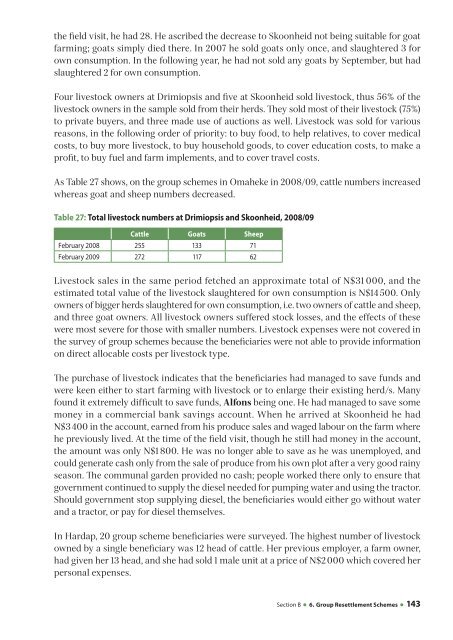Namibia country report
Namibia country report
Namibia country report
- No tags were found...
Create successful ePaper yourself
Turn your PDF publications into a flip-book with our unique Google optimized e-Paper software.
the field visit, he had 28. He ascribed the decrease to Skoonheid not being suitable for goatfarming; goats simply died there. In 2007 he sold goats only once, and slaughtered 3 forown consumption. In the following year, he had not sold any goats by September, but hadslaughtered 2 for own consumption.Four livestock owners at Drimiopsis and five at Skoonheid sold livestock, thus 56% of thelivestock owners in the sample sold from their herds. They sold most of their livestock (75%)to private buyers, and three made use of auctions as well. Livestock was sold for variousreasons, in the following order of priority: to buy food, to help relatives, to cover medicalcosts, to buy more livestock, to buy household goods, to cover education costs, to make aprofit, to buy fuel and farm implements, and to cover travel costs.As Table 27 shows, on the group schemes in Omaheke in 2008/09, cattle numbers increasedwhereas goat and sheep numbers decreased.Table 27: Total livestock numbers at Drimiopsis and Skoonheid, 2008/09Cattle Goats SheepFebruary 2008 255 133 71February 2009 272 117 62Livestock sales in the same period fetched an approximate total of N$31 000, and theestimated total value of the livestock slaughtered for own consumption is N$14 500. Onlyowners of bigger herds slaughtered for own consumption, i.e. two owners of cattle and sheep,and three goat owners. All livestock owners suffered stock losses, and the effects of thesewere most severe for those with smaller numbers. Livestock expenses were not covered inthe survey of group schemes because the beneficiaries were not able to provide informationon direct allocable costs per livestock type.The purchase of livestock indicates that the beneficiaries had managed to save funds andwere keen either to start farming with livestock or to enlarge their existing herd/s. Manyfound it extremely difficult to save funds, Alfons being one. He had managed to save somemoney in a commercial bank savings account. When he arrived at Skoonheid he hadN$3 400 in the account, earned from his produce sales and waged labour on the farm wherehe previously lived. At the time of the field visit, though he still had money in the account,the amount was only N$1 800. He was no longer able to save as he was unemployed, andcould generate cash only from the sale of produce from his own plot after a very good rainyseason. The communal garden provided no cash; people worked there only to ensure thatgovernment continued to supply the diesel needed for pumping water and using the tractor.Should government stop supplying diesel, the beneficiaries would either go without waterand a tractor, or pay for diesel themselves.In Hardap, 20 group scheme beneficiaries were surveyed. The highest number of livestockowned by a single beneficiary was 12 head of cattle. Her previous employer, a farm owner,had given her 13 head, and she had sold 1 male unit at a price of N$2 000 which covered herpersonal expenses.Livelihoods after Section Land Reform: B ● 6. Group <strong>Namibia</strong> Resettlement <strong>country</strong> <strong>report</strong> Schemes (2010) ● 143
















